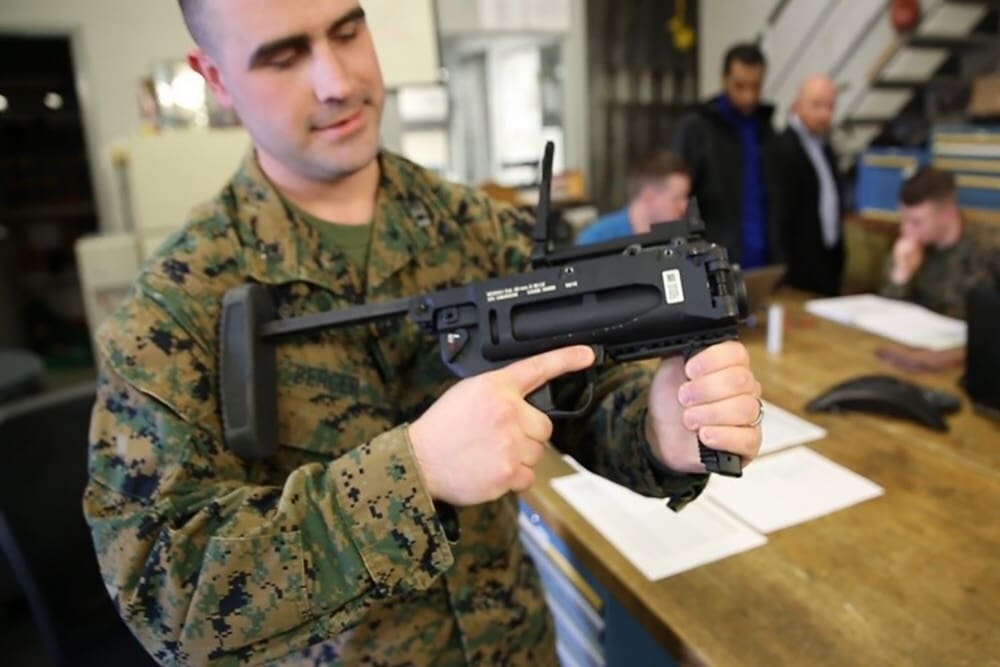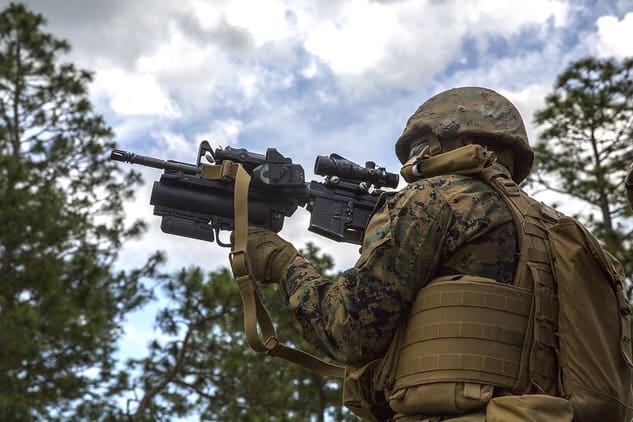MARINE CORPS BASE QUANTICO, Va. —
The Marine Corps plans to introduce a new weapon intended to enhance the lethality of infantry Marines on the battlefield.
The M320A1 is a grenade launcher that can be employed as a stand-alone weapon or mounted onto another, such as the M27 Infantry Automatic Rifle. Scheduled to be fielded in fiscal year 2020, the system will give fleet Marines the ability to engage with enemies near and far, day or night.

“The M320A1 will provide good range and accuracy, making the infantry squad more lethal,” said Lt. Col. Tim Hough, program manager for Infantry Weapons in Marine Corps Systems Command’s Ground Combat Element Systems.
The functionality of the M320A1 makes it unique, said Hough. Its ability to be used as a stand-alone or in conjunction with a firearm should help warfighters combat enemy forces. The weapon will replace the M203 grenade launcher, currently employed by Marines.
“The mounted version of the M320A1 is a capability we’re currently working on so that Marines have that option should they want it,” added Hough.
Before the Marine Air-Ground Task Force receives the M320A1, the Corps must draft technical documents for the weapon. These publications provide Marines with further information about the system.
In early March, Ground Combat Elements Systems collaborated with fleet maintenance Marines and logisticians from Albany, Georgia, conducting various analyses to determine provisioning, sustainment and new equipment training requirements for the system.
The first evaluation was a Level of Repair Analysis, or LORA. A LORA determines when a system component will be replaced, repaired or discarded. This process provides information for helping operational forces quickly fix the weapon should it break.
The LORA establishes the tools required to perform a task, test equipment needed to fix the product and the facilities to house the operation.
“It’s important to do the LORA now in a deliberate fashion so that we don’t do our work in front of the customer,” explained Hough. “And it ensures the system they get is ready to go, helping them understand the maintenance that must be done.”

The second evaluation was a Job Training Analysis, which provides the operational forces with a training package that instructs them on proper use of the system to efficiently engage adversaries on the battlefield.
“This process helps us ensure this weapon is both sustainable and maintainable at the operator and Marine Corps-wide level,” said Capt. Nick Berger, project officer in Infantry Weapons at MCSC. “It sets conditions for us to field the weapon.”
Analyses supports sustainability
Sustainability is a key factor in any systems acquisition process. The goal of the LORA and Job Training Analysis is to ensure the operator and maintenance technical publications of a system are accurate, which reduces operational ambivalence and improves the grenade launcher’s sustainability.
The LORA is an ongoing process that continues throughout the lifecycle of the M320A1 to establish sustainability, said Hough. After fielding the M320A1, the Corps will monitor the system to ensure it is functioning properly.
During this time, the program office will make any adjustments and updates necessary.
“We’re looking to have the new equipment training and fielding complete prior to fourth quarter of FY19 to ensure they can be used and maintained properly once they hit the fleet,” said Berger.
The analyses, which occurred over the course of a week, were no easy task.
“This was an extensive and arduous process,” explained Hough. “We scheduled three days for the LORA—all day—so you’re looking at about 24 hours of work for the LORA. And that doesn’t include reviews, briefs and refinements to the package.”
However, at the end of the week, Hough expressed gratitude for all parties involved in the M320A1 analyses, which he called a success. He said the tasks could not have been completed without the help of several key individuals.
“I will tell you what’s noteworthy is working with our contract support, the outside agencies and the deliberate efforts by our team—specifically Capt. Nick Berger and Steve Fetherolf, who is a logistician,” said Hough. “Those two have made a significant effort to get this together and move forward.”
Berger also expressed pride about the accomplishments of the analyses.
“This week has been a success,” he said. “We got the system in Marines’ hands, worked out the kinks and began to understand how we’re going to use this moving forward.”
By Matt Gonzales, MCSC Office of Public Affairs and Communication | Marine Corps Systems Command
Photo of Marine firing M230A1 by LCpl Taylor W Cooper.


Christ, 10 years after the 82nd was deploying with this system. Damn.
Hated it. Please bring back the 203. Better as a stand-alone weapon but unless you’re going to go back to an M79 gunner, the 203 is a better system for integrating into a modern infantry platoon.
Please list how the 203 is better.
Oh it’s just like anything, it’s new but we like the old. I know the 320 is a better system (and I do really like it) but I threw a lot of 40mm at Johnny Von Talibon with the 203 and it holds a special place in my heart.
Exactly what I figured. By all accounts it is much more accurate and versatile.
If you have fired them side by side, and witnessed and mentored others as they did the same, you would know why m203 is a superior system for under-barrel use. Unquestionably m320 offers some technological advances, make an excellent stand-alone system, and have their place (FOB/COP defense, gunner back-up weapon, etc) But on patrol if I need a grenade launcher system on my rifle, I would choose an m203 every time. Even with a massive adrenaline dump and adequate hours in the gym, m320 is cumbersome to the point of being a hindrance. M203 is slightly better, but better enough to make it usable. Just one grunt’s opinion.
What I don’t understand is why there is a need for a weapon mounted version at all now that the stand-alone is a proven platform. Isn’t it disadvantageous to have that much weight on your rifle?
My knowledge of this topic is severely limited so I’m hoping to be enlightened.
Ergonomics if it’s underbarrel is straight garbage. JHP is correct. Standalone you won’t have any issues but once you mount it, you won’t be able to use either your M4 or the 320 effectively. The weight is farther off the weapon than the 203 used to be and makes humping it a bitch, and clumsy. Good luck in MOUT. You’ll have a harder time getting stable with either weapon because of how big the 320 is. The bigger 40mm smart rounds, the whole reason for the side loading 320, has yet to be a thing; meanwhile you kinda just made life harder for left handed grunts used to the 203 which was ambi. 203 fits the M4 much better.
“If it ain’t broke…”
But like said before, all these problems go away if used standalone. Mounted is stupid.
And the optional finger guard should be mandatory. The new IR sight is pretty boss; leaf sight should be metal – they break easily. Just saying.
It could be argued that mounting any grenade launcher is a poor decision for many reasons. They are front heavy as hell and make using either weapon an issue.
Maybe don’t ever mount a grenade launcher to another small arms,weapons system because it’s dumb?
203 is fine mounted. 320 is not.
And 203 sucks as a stand alone, 320 does not suck.
The weapon system was great as a standalone system. Strip off the leaf and electronic estimation sights and you’ve got yourself a regular thumper
pogue playing with his toy in the office lol